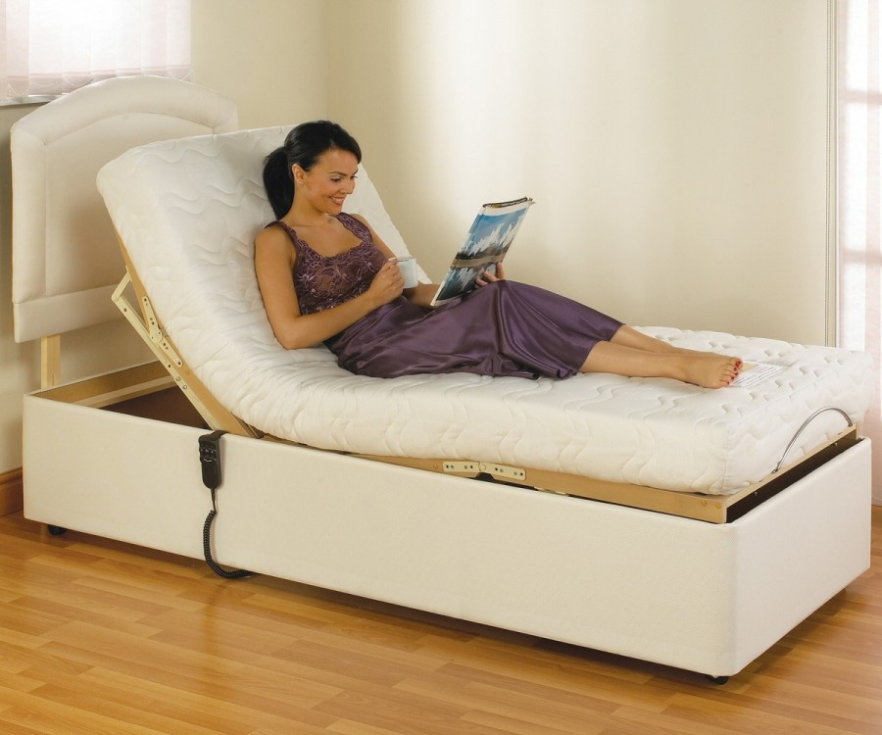Let’s be honest – everyone would have an adjustable bed if they could. There is no real downside to being able to angle and pivot your upper and lower body any which way you like, other than the cost of the bed itself.
But let’s take a step back and look at the big picture. Adjustable beds are most popular in health and social care settings because they assist with mobility. Some people don’t require that extra mobility, so the extra cost is hard to justify.
This article will look at the pros and cons of adjustable beds to help you decide whether or not an adjustable bed is right for you.
Let’s start with the pros!
Adjustable bed pros
These are the pros of an adjustable bed:
Enhanced mobility
Adjustable beds bases make it easier to get in and out of bed. You can adjust the bed to a comfortable entry and exit position, get into bed and then readjust the bed to make it highly comfortable for when you sleep.
Customised sleeping position
If sleeping flat on your back gives you trouble, being able to raise your upper body and legs will work wonders for comfort. Even a tiny adjustment that raises the height of your head can reduce discomfort in your lower back.
Pain relief
If you have pain in bed, adjusting your sleeping position could relieve it. For example, increased leg height improves blood flow, reduces pins and needles, and elevating your head can relieve pressure on your hips.

Pictured: Sleepeezee Gel Comfort 1000 2FT 6 Small Single Adjustable Bed, Available from Bedstar. The Online Bed Superstore.
Health benefits
Sleeping with an elevated head improves breathing, helping reduce the symptoms of sleep apnea and snoring. Additionally, sleeping with feet elevated helps reduce the symptoms of oedema (feet swelling) and improves blood flow.
Ottoman storage
You can get adjustable beds with an ottoman base, where the slatted mattress base lifts to reveal a massive amount of storage. Ottoman adjustable beds are fantastic for small bedrooms because they hide bedding, shoes and bits and bats.
Great mattresses
Adjustable beds are sold with special mattresses that fold and flex with the bed. Most mattresses are pocket sprung or reflex foam varieties; reflex foam mattresses are squishy and dense, while sprung mattresses are bouncy.
No messing about with pillows
Putting pillows under your legs to elevate your feet and sleeping with more than one pillow under your head is a faff. Not only that, but it’s also not ideal for comfort. An adjustable bed offers a simpler, more efficient way to get comfortable.
Adjustable bed cons
These are the cons of an adjustable bed:
Expensive relative to regular beds
Adjustable beds cost 20-40% more than regular beds because they have an electric motor and mechanical lifting aids. The extra cost is enough to deter many people, although they are hardly outrageously priced.
Solid base only
Adjustable beds have a solid base made from engineered timber or hardwood, wrapped in upholstery. If you don’t like beds with an upholstered base, an adjustable bed probably won’t meet your aesthetic requirements.
Heavy and cumbersome
Adjustable beds weigh more than regular bed frames because of the electric motor and mechanical parts. All the extra weight is in the base. If you plan to move the bed around, you might need someone to help you.
Limited options at larger sizes
While single adjustable beds are abundant, double adjustable beds are rarer, and king-size adjustable beds are even rarer still. The bulkiness of large adjustable beds may also deter you from considering one over a regular bed.
Summing up
Adjustable beds or luxury hospital beds enhance mobility, customise your sleeping position, relieve back pain, offer health benefits and make it easier to get comfortable. Conversely, they are expensive, heavy and come with limited options at larger sizes.
Ultimately, adjustable beds are worth it if they fit your lifestyle. If you don’t benefit from an adjustable sleeping position, look at regular beds instead.












